Physical Address
304 North Cardinal St.
Dorchester Center, MA 02124
Rhytidectomy has been performed in the United States for at least a century. During this time, the technique for performing the operation has undergone marked evolution. To date, no consensus exists among experts regarding what technique achieves the appropriate balance between aesthetic result and the risk of complications.
Rhytidectomy involves rejuvenating the aging face by reversing the gravitational effects of aging. The loose skin of the neck is most improved, followed by the jowls and the melolabial fold (MLF). Regardless of the technique chosen, the MLF is the most difficult problem to address.
The two most common rhytidectomy procedures are the superficial musculoaponeurotic system (SMAS) rhytidectomy and deep-plane rhytidectomy.
SMAS rhytidectomy involves using a longer skin flap. The SMAS may be either plicated or imbricated. During plication the SMAS is folded upon itself and secured with suture; imbrication involves excising a segment of SMAS prior to suturing. This technique may have a lower risk of nerve injury.
A deep-plane rhytidectomy involves the use of a shorter skin flap prior to transitioning to the deep plane or sub-SMAS dissection. This procedure may have a higher risk of motor nerve injury, lower risk of hematoma, and potentially improved benefit over SMAS rhytidectomy with respect to the MLF.
Regardless of the technique chosen by the rhytidectomy surgeon, a detailed knowledge of facial anatomy is imperative to the surgeon's ability to perform a safe and effective procedure.
The SMAS includes the mimetic muscles of facial expression—platysma, zygomaticus major and minor, orbicularis oris and oculi, and frontalis—and the fascial extension of these muscles. Posterolaterally, the SMAS coalesces with the fascia that invests the sternocleidomastoid muscle. Inferiorly, it is continuous with the platysma muscle, whereas superiorly it is continuous with the superficial temporal fascia (temporoparietal fascia). This layer is superficial to and distinct from the investing fascia of the parotid gland.
The great auricular nerve (GAN), a sensory nerve, is the most commonly injured nerve in rhytidectomy surgery. The most commonly injured motor nerve is the facial nerve, and the facial nerve branches most commonly injured during rhytidectomy are the temporal, marginal mandibular, and cervical branches.
The most common complication of rhytidectomy is hematoma, and the biggest risk factor for hematoma formation is postoperative hypertension.
Submentoplasty or submental liposuction is an important part of any rhytidectomy procedure. In and of themselves these yield an aesthetic benefit in the aging submental neck. Furthermore, the subcutaneous dissection in the submental neck allows adequate mobilization of the platysma, an integral part of the SMAS, for SMAS advancement and rotation during rhytidectomy. In addition, the dissection allows the neck skin to be adequately advanced during the skin redraping.
In 1907, Miller published the first medical book on the subject of cosmetic surgery, and thus was born the field of aesthetic surgery.
Eugene von Hollander is often credited with the first rhytidectomy performed on a Polish aristocrat in 1901, which was described in 1912 and took the primitive form of excising skin and repairing the wound without undermining the facial skin.
Early facelift techniques were probably developed by German surgeons.
By 1906, American surgeons were beginning to adopt and improve the techniques of facelifting.
By 1926, surgeons were using coronal incisions for forehead lifting and developing methods of dealing with redundant neck skin.
Before World War II, aesthetic surgery was looked on with disfavor by organized medicine, which held that such surgery was not warranted because of associated risks.
After World War II, the development of antibiotics and improved anesthesia provided safer elective surgery.
By 1960, the greater affluence of the middle class and changing attitudes helped spawn a renewed interest in rhytidectomy.
Significant innovations in facelifting were introduced in the 1970s by the work of Skoog, who reported dissecting beneath the superficial fascia of the face.
Prior to 1974, rhytidectomy consisted of a simple subcutaneous dissection of facial and cervical skin with or without suture suspension of the underlying superficial fascia. Skoog demonstrated that an advancement flap dissected beneath the superficial fascia, later to be named the superficial musculoaponeurotic system (SMAS), could improve the jaw line better than a subcutaneous dissection of the skin while leaving the overlying skin attached. This discovery represented a paradigm shift in rhytidectomy surgery. Skoog's report created considerable interest in the superficial fascia and led to the 1976 report by Mitz and Peyronie, which, along with subsequent studies, showed that the SMAS is a fibromuscular fascial extension of the platysma muscle that is continuous with the temporoparietal fascia and envelops facial mimetic musculature.
Surgeons familiar with the subcutaneous facelift began incising the SMAS superficial to the parotid gland and creating a rotation-advancement SMAS flap. Others made incisions through the SMAS anterior to the parotid gland and dissected beneath the platysma to create a musculocutaneous advancement flap, which was suspended posterosuperiorly to the fascia of the parotid gland. Some excised a strip of SMAS and reapproximated it rather than dissecting beneath it. Although the SMAS flap dramatically improved the jowl, it had limited improvement of the melolabial fold (MLF) and midface. The midface is the portion of the cheek that lies between the lower eyelid and the level of the oral commissure.
The MLF continued to present a problem for the rhytidectomy surgeon, because standard facelifting techniques placed traction on the SMAS; however, the amount of traction placed on the SMAS is not fully transmitted to the MLF and as a consequence does not completely ameliorate the fold. This is likely because the SMAS is effectively anchored by the bony origins of the mimetic muscles it envelops, especially the zygomaticus major muscle in the region of the body of the zygoma. This point of fixation prevents the upward lateral displacement of a sub-SMAS rhytidectomy flap and flattening of the MLF. In 1989, Furnas described the ligaments of the midface, showing that the zygomatic retaining ligament anchors the skin of the cheek to the inferior border of the zygoma and the release of this ligament allows for the most effective vertical lift of the SMAS-platysma complex from the neck to the cheek. This finding led to the realization that a sub-SMAS dissection must release the investments of the SMAS to the zygomatic musculature to move the SMAS and the overlying cheek fat upward, thus improving the MLF. This technique is referred to as the deep-plane rhytidectomy , which was perfected by Hamra, who extended a sub-SMAS dissection of the inferior cheek superiorly, cutting through the SMAS peripherally and releasing it from its investment of the zygomatic muscles so that the SMAS and the overlying skin and subcutaneous tissues could be advanced superolaterally. The dissection extended medially beyond the MLF and totally released all SMAS attachments to the dermis of the upper lip to create a thick musculocutaneous flap composed of skin, subcutaneous fat of the cheek, and the platysma. Hamra subsequently modified the deep-plane rhytidectomy by including the orbicularis oculi in the rhytidectomy flap and termed it a composite rhytidectomy . Owsley showed that by dissecting medially from the malar eminence to the lateral upper lip just superficial to the SMAS in the plane immediately above the orbicularis oculi, zygomaticus, and levator muscles, the cheek fat could be completely freed, allowing it to be suspended superiorly to restore a youthful appearance to the midface and efface the MLF. His work suggested that a sub-SMAS dissection may not be necessary to improve the midface. Owsley's approach is often referred to as an extended supra-SMAS rhytidectomy . While of historic importance, extensions and modifications of the deep-plane rhytidectomy, such as composite rhytidectomy and extended supra-SMAS techniques, will not be discussed in detail to remain within the scope of the chapter. Contemporary rhytidectomy surgeons generally perform either an SMAS rhytidectomy or deep-plane rhytidectomy.
To obtain a complete understanding of the rhytidectomy procedure, the pathophysiology and anatomic changes that occur during facial aging must be understood. These changes manifest in the skin, soft tissue, and bony facial skeleton ( Fig. 24.1 and Table 24.1 ).
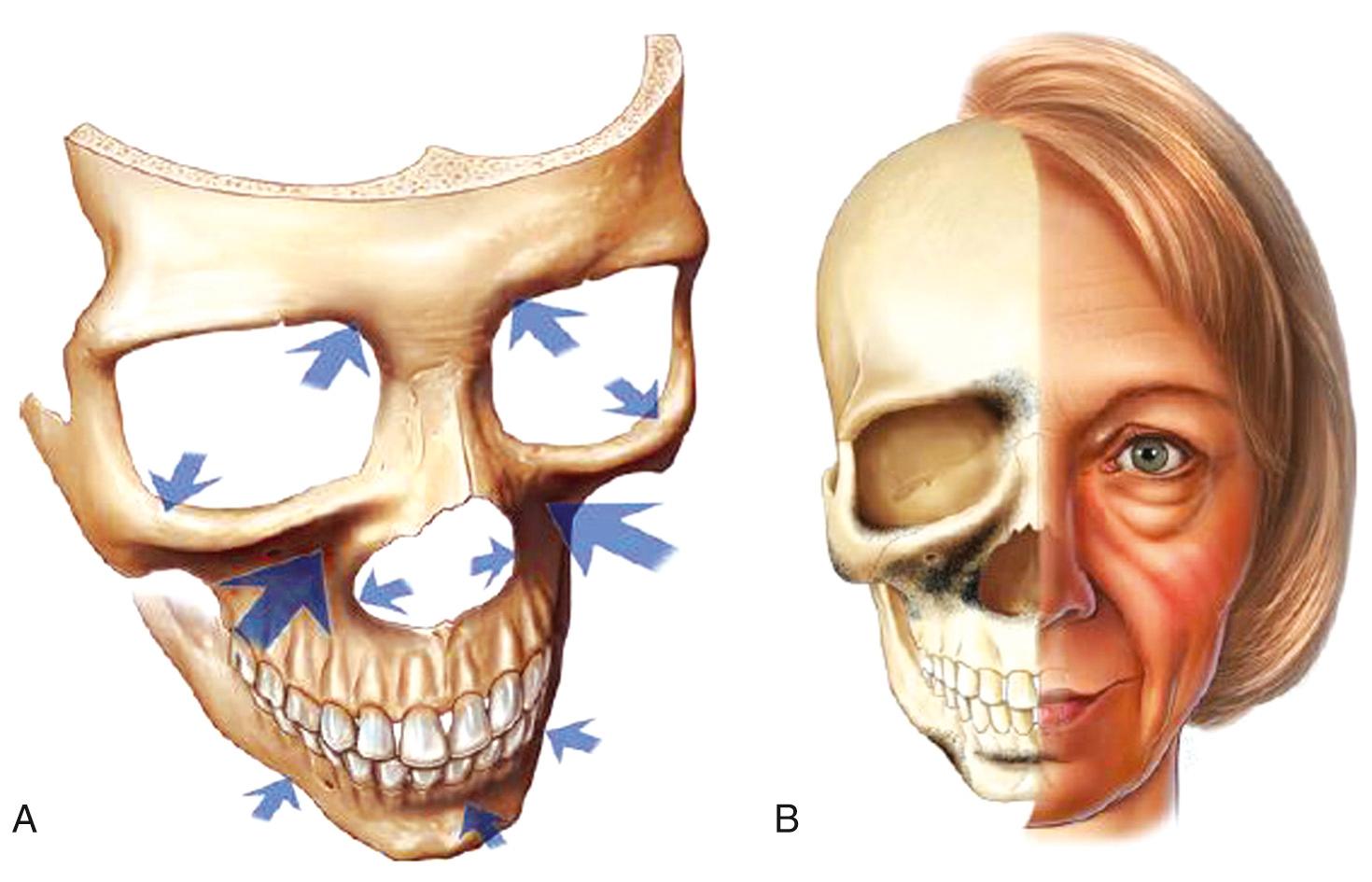
| Youthful Face | Aging Face | |
|---|---|---|
| Skin |
|
|
| Periorbital |
|
|
| Midface |
|
|
| Perioral |
|
|
| Cervicomental |
|
|
The most noticeable changes occur in the skin.
Increased laxity, decreased elasticity, and actinic damage are visible in the form of:
Lentiginous dyschromia and actinic keratosis
Telangiectasias
Coarse and fine rhytids
At the level of the soft tissue, facial lipoatrophy occurs with:
Formation of hollows, especially in the temporal area, infracommissural area, prejowl, and cheeks
Skeletal changes include:
Superomedial and inferolateral remodeling of the orbital rim leading to overall widening of orbital aperture
Posterior displacement of maxilla
Shrinking of the mandible in vertical and horizontal planes
During the evolution of modern facelifting techniques, Yousif and colleagues investigated the anatomy of the MLF and found that the fold resulted from descent of the anterior cheek fat and overlying attached skin. As the face ages, the cheek fat of the midface descends inferomedially. This tissue migration has the effect of enhancing the MLF and deepening the melolabial crease. At the same time, the orbicularis muscle of the lower eyelid stretches and descends inferolaterally. This movement causes the margin of the lower eyelid to move below the inferior limbus, which produces scleral show. The junction between the cheek and lower eyelid descends below the orbital rim and causes skeletonization of the inferior bony orbital rim and, in some patients, leads to the development of a nasojugal groove. Furthermore, the aging facial skeleton contributes to the changes we perceive in the aging face. Recent anthropometric studies of the aging facial skeleton reveal that bone resorption occurs more rapidly in selected areas of the facial skeleton, with the maxilla and periorbital facial skeleton undergoing more rapid resorption.
Within the lower third of the face as well as the neck, a number of changes contribute to an aged appearance. Jowl formation, one of the primary complaints of patients, occurs from the combination of facial lipoatrophy, increased skin laxity, and reduced mandibular height. Jowl formation interrupts a well-defined mandibular border. The youthful neck has a cervicomental angle between 90 and 105 degrees, with the vertex at the hyoid bone and the superior limb of this angle extending tangentially to the gnathion and inferiorly to the sternal notch. This angle is maintained by multiple variables that include taut submental skin with minimal submental adipose tissue, a high-positioned hyoid bone, and a strong mentum. In addition, the youthful neck includes a well-visualized thyroid cartilage and anterior border of the sternocleidomastoid (SCM) muscle. Excess skin laxity and submental adiposity, anterior platysmal banding, a low-positioned hyoid, and a weak chin can contribute to effacement of the cervicomental angle and a “turkey gobbler” appearance of the submental region on profile view ( Fig. 24.2 ).
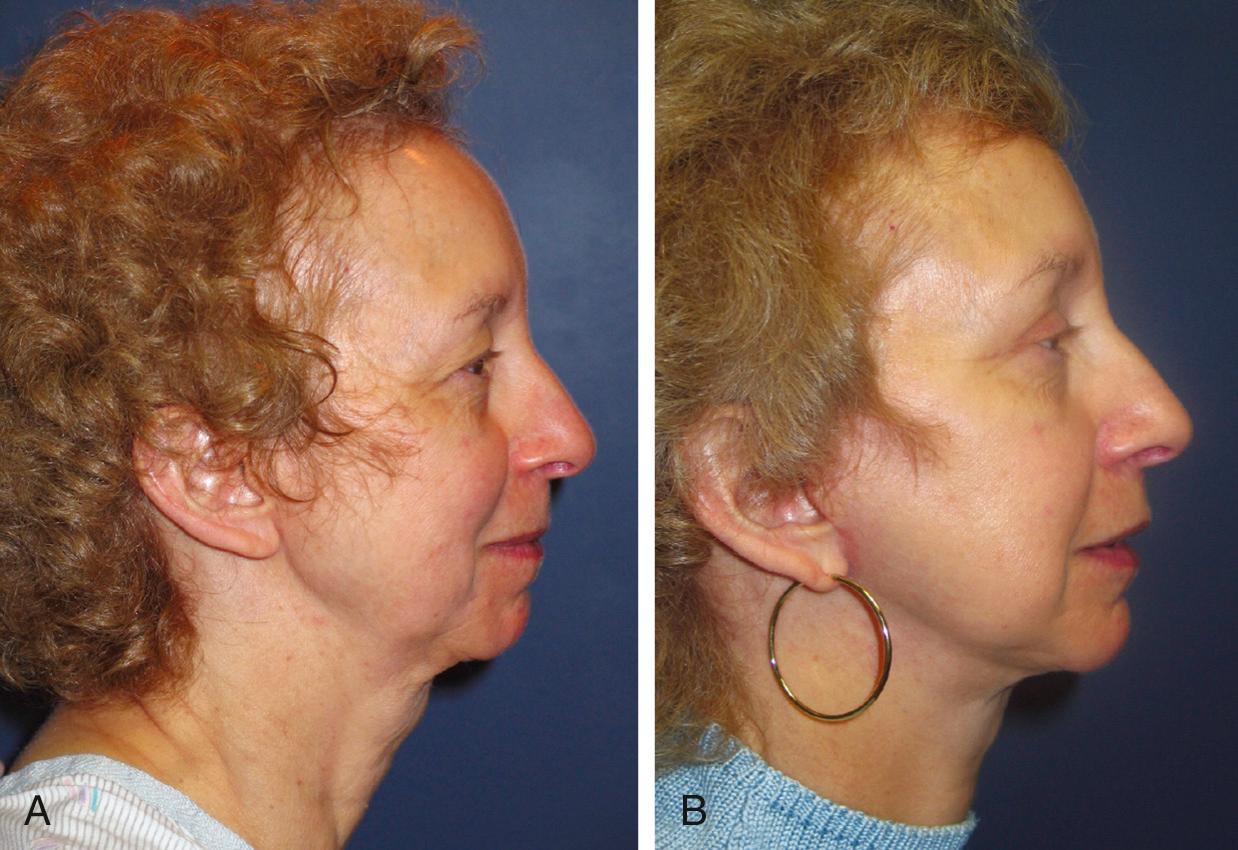
In summary, aging of the skin, facial lipoatrophy, dermatochalasis, and skeletal resorption lead to the typical signs of aging, including:
Melolabial folds
Infracommissural folds
Nasojugal folds
Hollowing of the eyes and temple regions
Scleral show
Skeletonization of the orbital rim
Jowl formation
Effacement of the cervicomental angle
Platysmal banding
As mentioned previously, there has been no greater discovery in the evolution of rhytidectomy surgery when compared with the description of the SMAS as a distinct entity of the surgical anatomy of the face. For decades, facelifting operations were focused primarily on resection and tightening of the skin, until Skoog described a subfascial dissection, which led to the description of the SMAS by Mitz and Peyronie. All contemporary rhytidectomy techniques involve a dissection and mobilization of the SMAS in some capacity.
Here are several facts about the SMAS:
It is a fibromuscular structure superficial to the parotid fascia.
It begins inferiorly as the platysma muscle in the neck.
It ends superiorly in the temporal area as the superficial temporal fascia (temporoparietal fascia).
Anteriorly, the SMAS invests the mimetic muscles of the face ( Fig. 24.3 ).
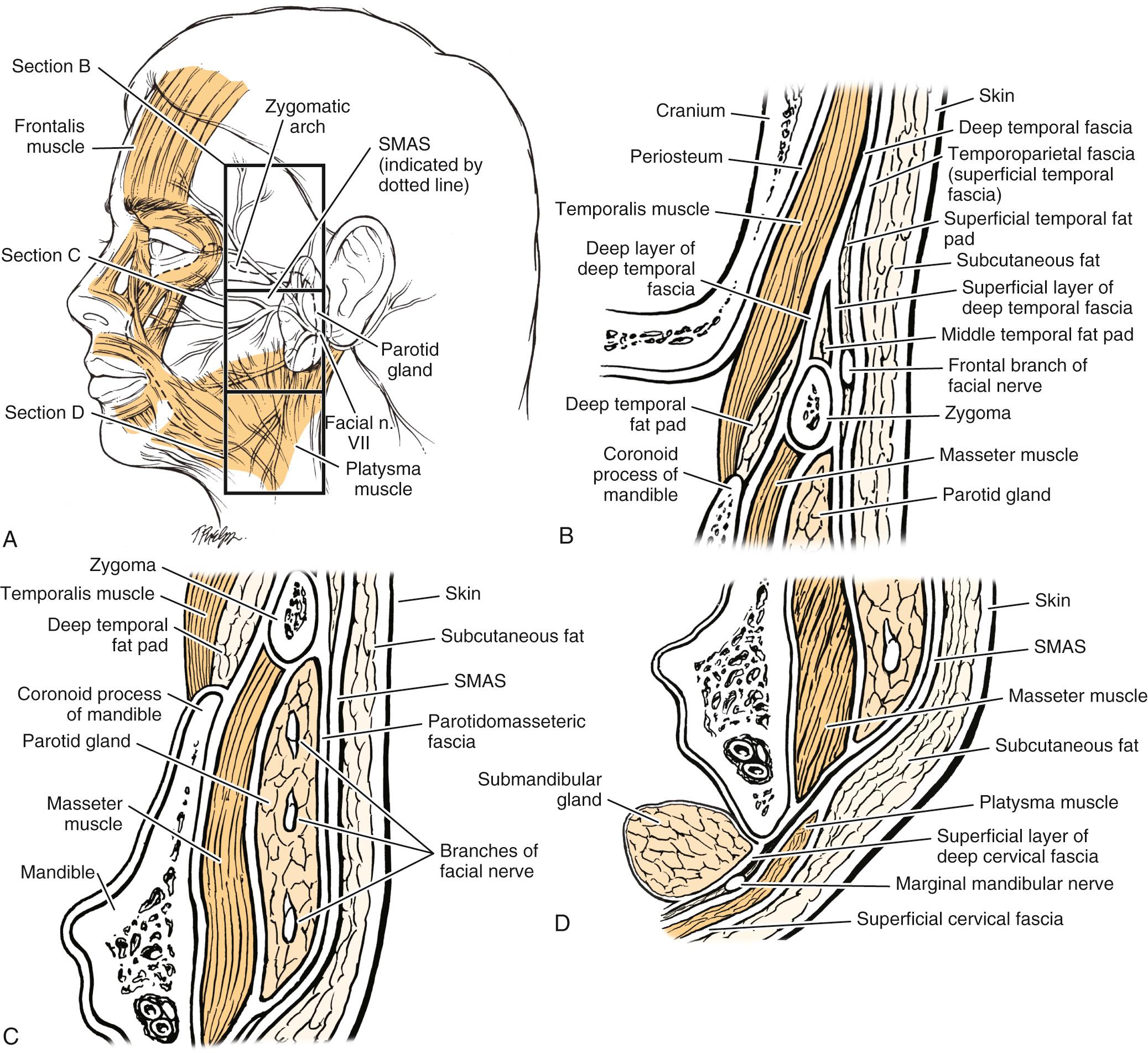
It terminates posteriorly, where its fibrofascial layer coalesces with the investing fascia of the SCM muscle.
In all anatomic areas of the face and neck, the SMAS is superficial to the motor branches of the facial nerve.
Sensory branches can be encountered going through the SMAS to the subcutaneous tissue and dermis in the region of the cheek.
Because the facial nerve is the most common motor nerve injured during rhytidectomy procedures, a thorough understanding of the nerve's anatomy is imperative. After leaving the stylomastoid foramen, the main trunk of the facial nerve immediately enters the parenchyma of the parotid gland, where it travels a short distance before branching into its upper and lower divisions. The secondary branching pattern of the facial nerve is highly variable yet generally contains five branches: (1) temporal (frontal), (2) zygomatic, (3) buccal, (4) marginal mandibular, and (5) cervical. As a rule, the facial nerve enters deep to the muscles it innervates with the exception of the levator anguli oris, buccinator, and mentalis muscles. Lying within the parotid gland, the facial nerve is fairly well protected. However, the frontal branch quickly exits the parotid gland superiorly and crosses the zygomatic arch within the loose areolar tissue in the superficial temporal fascia and superficial to the periosteum at the midpoint of the zygomatic arch; it is most vulnerable in this area, and consequently, it is the most frequently injured branch of the facial nerve during rhytidectomy. Fortunately, the location of the frontal branch can be predicted using surface anatomic landmarks. Pitanguy and Ramos described the location of the frontal branch as coursing 0.5 cm inferior to the tragus to 1.5 cm superior to the lateral eyebrow. In the neck, the marginal mandibular nerve travels within the fascia that overlies the submandibular gland and deep to the platysma muscle. It is more commonly injured when submentoplasty is performed during excision of fat from beneath the platysma muscle.
The great auricular nerve (GAN) supplies sensory innervation to the inferior auricle and periauricular area, and it emerges along the posterior surface of the SCM muscle, approximately 6.5 cm inferior to the bony external auditory canal. At this point the nerve is relatively superficial, which renders it vulnerable to injury during skin flap elevation. Superiorly, it travels deep to the SMAS, where it is protected from injury.
At the outset of the rhytidectomy procedure, prior to injection of local anesthetic, the appropriate skin incisions and skin flaps should be planned and marked on the patient ( Fig. 24.4 ).
Temporal hairline
Incision is curved to follow hairline
Avoid placing incision superior to root of the helix as this can lead to an unnatural “operated-on” postoperative appearance
Preauricular
Follow the curvature of the crease anterior to the helical cartilage
Tragal marking
Female: incision is placed on its posterior surface, almost inside the canal
Male: incision should be placed in a pretragal location to avoid advancing hirsute facial skin or sideburns onto the naturally hairless tragus
Lobule
Skin marking emerges inferior to the tragus and enters the crease just anterior to the lobule and follows this crease around the lobule
Postauricular
Incision follows the posterior surface of the conchal cartilage several millimeters anterior to the postauricular crease
Fibrosis and contraction of the healing skin flap will eventually bring this incision into the natural postauricular crease
Concha-mastoid junction
The incision should transition from the conchal cartilage to the mastoid surface at a right angle
At closure, this transition point is one of two points of maximal tension on the skin, the other being its preauricular counterpart; therefore a straight-line incision should be avoided here
Occipital hairline
A slightly rounded running W-plasty incision is preferable—a nonlinear scar is less conspicuous when completely healed
Care should be taken to preserve the natural occipital hairline to avoid an unnatural postoperative appearance
Skin flap marking
Regardless of technique, the skin flaps should be determined and marked prior to the start of the operation
SMAS rhytidectomy: approximately 6 to 7 cm
Deep-plane rhytidectomy: approximately 3 to 5 cm (generally requires a much shorter skin flap)
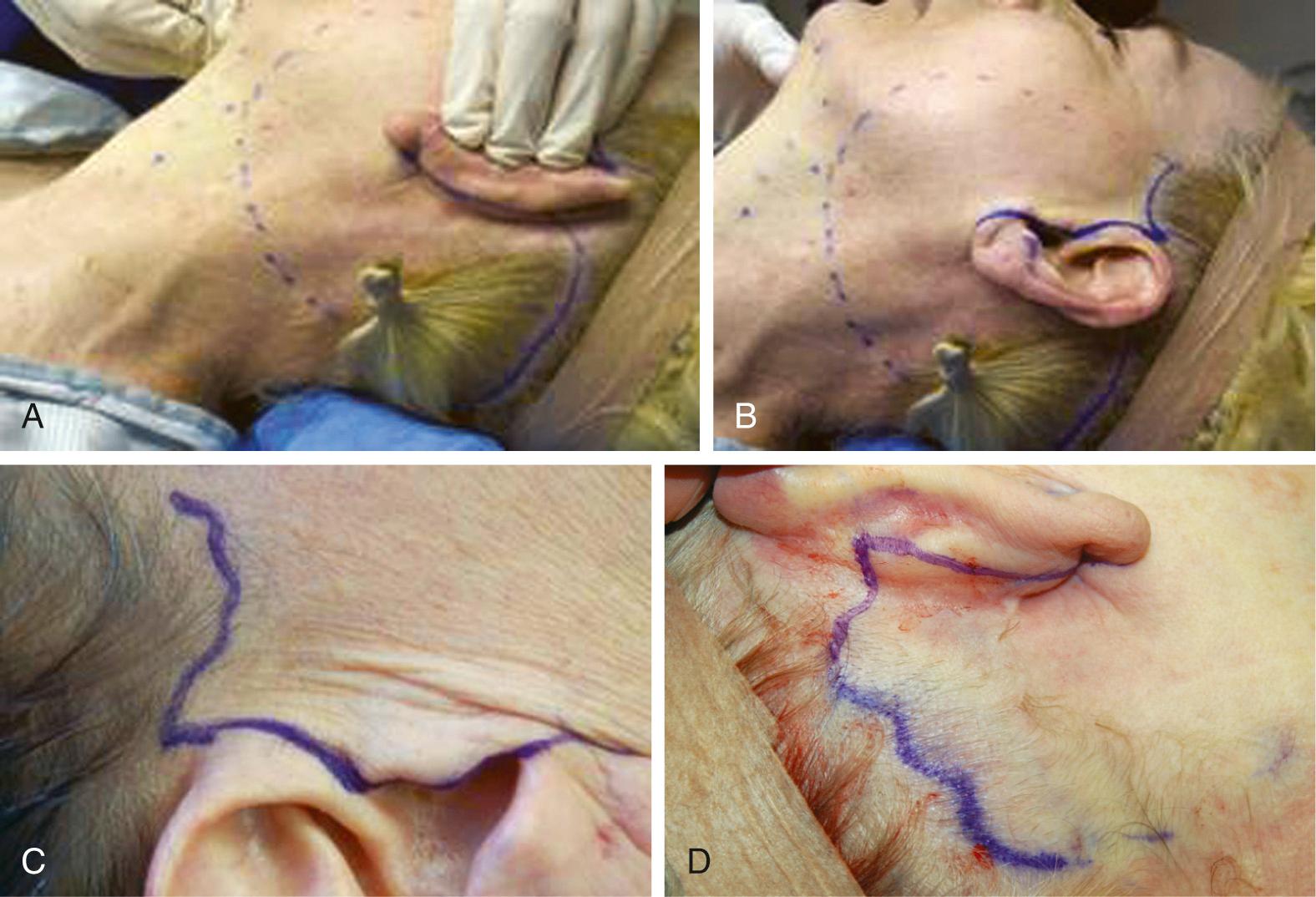
The incision and boundaries for submentoplasty are also marked preoperatively ( Fig. 24.5 ). A skin incision (4 to 5 mm for liposuction and 3 to 4 cm for submentoplasty) is marked horizontally in a submental skin crease. The thyroid notch, anterior borders of the bilateral SCM muscles, and bilateral inferior mandibular borders are marked to indicate the boundaries of either neck liposuction or skin flap elevation for submentoplasty.
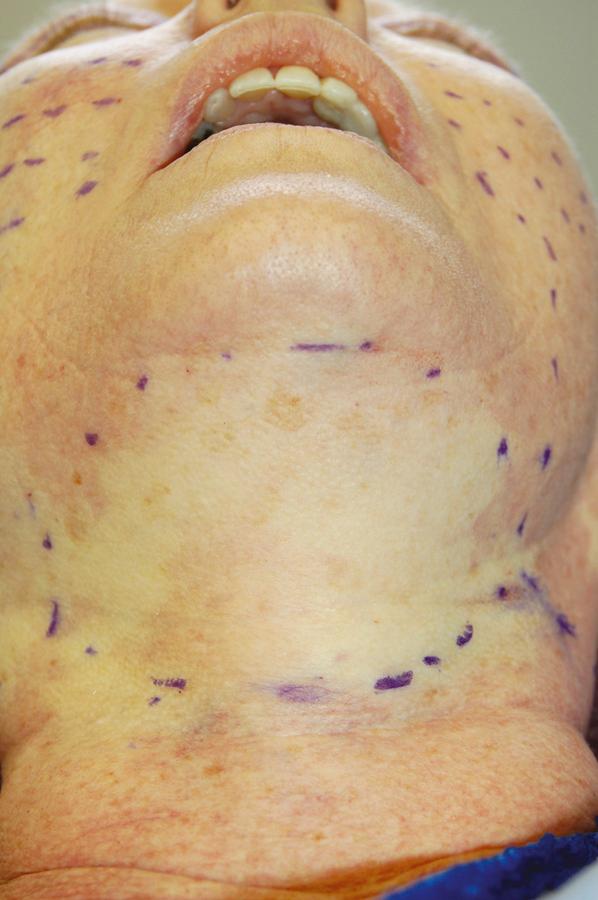
After the incisions are marked, adequate intravenous sedation is achieved, and local anesthetic is infiltrated into the subcutaneous plane. The contralateral incision is also injected prior to the start of the procedure. The authors recommend using an equal part mixture of 2% Xylocaine with epinephrine 1 : 100,000 and 0.5% bupivacaine with epinephrine 1 : 200,000 to obtain effective vasoconstriction and prolonged anesthesia. For submental liposuction and submentoplasty, the authors recommend using 0.5% Xylocaine with epinephrine 1 : 200,000. To obtain maximal vasoconstrictive effect from epinephrine, 15 to 20 minutes are allowed to elapse prior to incising the skin.
Regardless of the type of rhytidectomy technique used, submental liposuction and/or submentoplasty is universally performed; these are an integral part of the rhytidectomy procedure, which relies on dissecting the submental neck skin from the underlying platysma and superficial investing fascia of the neck, both of which are important components of the SMAS. Dissection in this plane, whether using liposuction cannulas or sharp instrumentation, allows for the advancement of neck skin during skin redraping and allows advancement of the SMAS for adequate rhytidectomy.
Create skin incision sharply.
1 to 2 cm of skin flap undermining is performed to allow cannula access to the appropriate plane.
For submentoplasty, the entire submental neck is widely undermined.
The liposuction cannula is inserted with its cutting edge facing away from the dermis.
Tunnels are created bluntly prior to the use of suction.
Next, suction is applied, and gentle pushing and pulling motions are made.
In contrast to scraping the adipose tissue away from the superficial surface of the platysma, care is taken to apply subtle outward tension on the undersurface of the dermis to allow the suction to draw the fat into the cannula for evacuation ( Fig. 24.6 ).
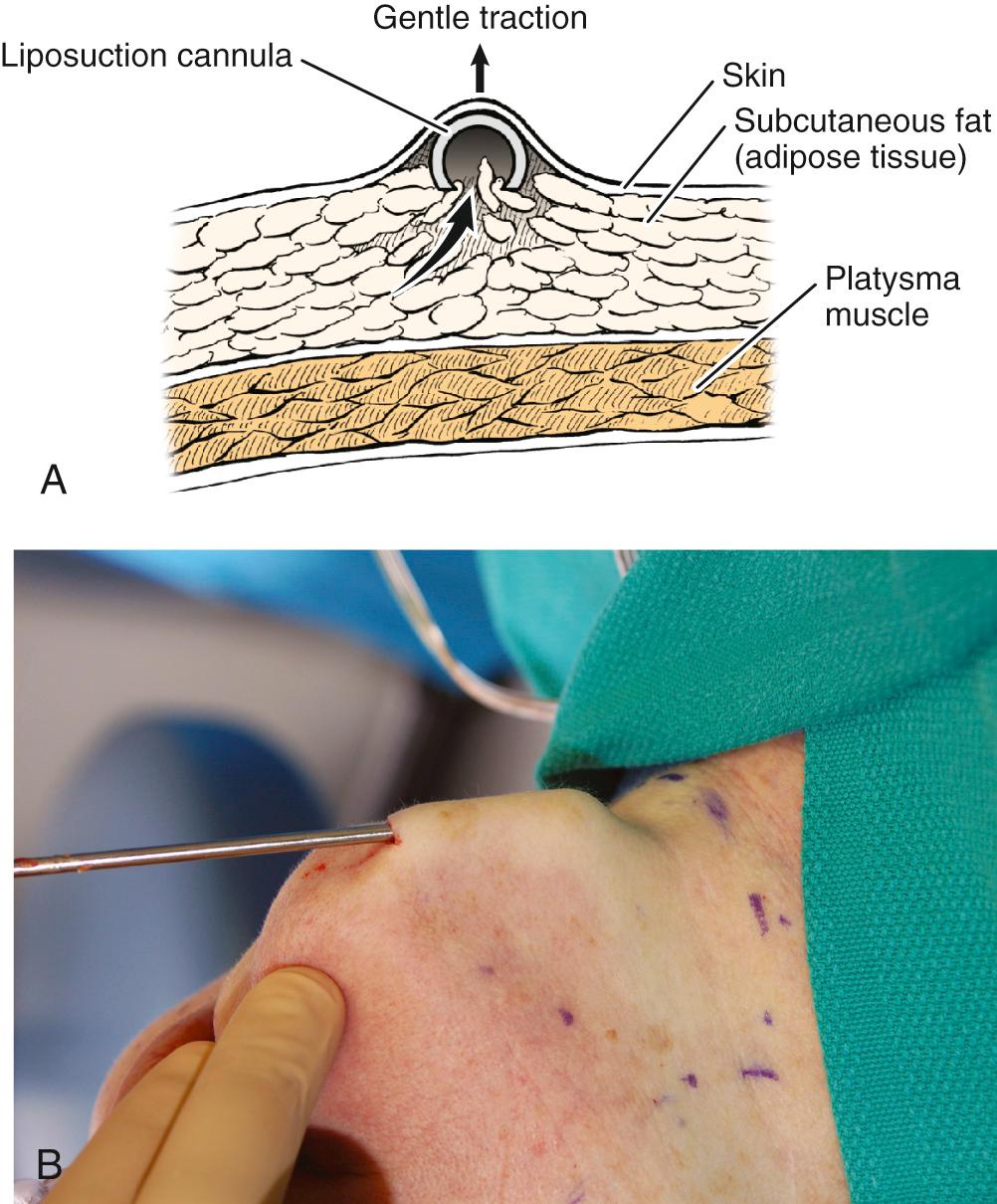
The procedure is complete when an appropriate amount of adipose tissue has been removed.
A conservative approach is favored.
Overly aggressive liposuction can yield complications such as scar banding and the so-called cobra neck deformity.
Become a Clinical Tree membership for Full access and enjoy Unlimited articles
If you are a member. Log in here